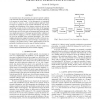Free Online Productivity Tools
i2Speak
i2Symbol
i2OCR
iTex2Img
iWeb2Print
iWeb2Shot
i2Type
iPdf2Split
iPdf2Merge
i2Bopomofo
i2Arabic
i2Style
i2Image
i2PDF
iLatex2Rtf
Sci2ools
105
Voted
ICASSP
2011
IEEE
2011
IEEE
Further analysis of latent affective mapping for naturally expressive speech synthesis
An essential step in the generation of expressive speech synthesis is the automatic detection and classification of emotions most likely to be present in textual input. At last Interspeech, we introduced latent affective mapping, a new emotion analysis approach which leverages two separate levels of semantic information: one that encapsulates the foundations of the domain considered, and one that specifically accounts for the overall affective fabric of the language [1]–[2]. The ensuing framework exposes the emergent relationship between these two levels in order to advantageously inform the emotion classification process. This paper presents further validation of latent affective mapping, as well as a detailed analysis of its behavior given the attendant richer emotional description. The various mapping instantiations supported compare favorably with more conventional techniques based on expert knowledge. In particular, representative case studies point to a better approximation...
Expressive Speech Synthesis | ICASSP 2011 | Latent Affective Mapping | Overall Affective Fabric | Signal Processing |
| Added | 20 Aug 2011 |
| Updated | 20 Aug 2011 |
| Type | Journal |
| Year | 2011 |
| Where | ICASSP |
| Authors | Jerome R. Bellegarda |
Comments (0)

